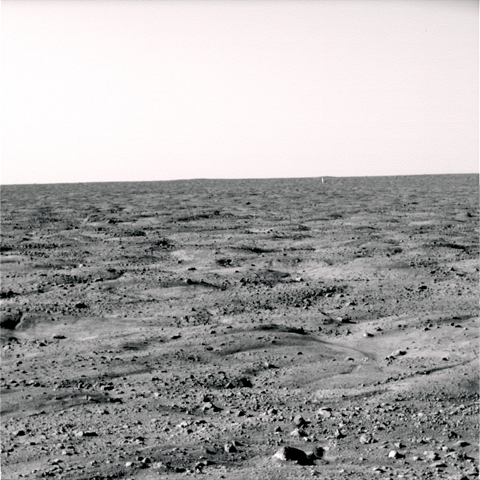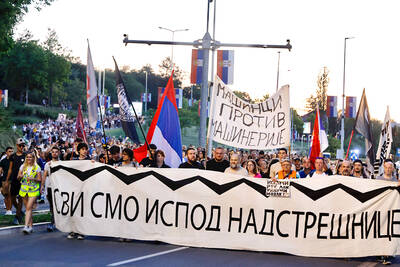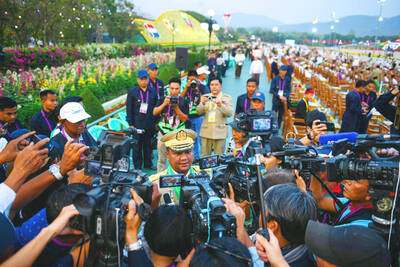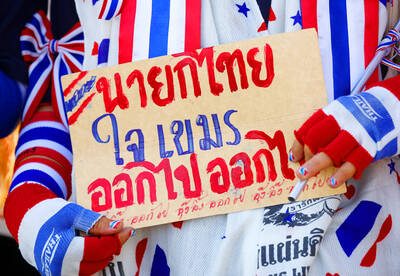NASA's Phoenix Mars lander spent its first full day in the Martian arctic plains checking its instruments in preparation for an ambitious digging mission to study whether the site could have once been habitable.
The three-legged lander set down on Sunday in relatively flat terrain covered by fissures outlining polygon shapes. The geometric cracks are likely caused by the repeated freezing and thawing of buried ice.
Images beamed back late on Monday showed the elbow joint of Phoenix’s trench-digging robotic arm still partly covered by a protective sheath. The sheath was supposed to fully unwrap after landing.

PHOTO: AP
Mission scientists downplayed the problem, saying they could still wiggle out the arm for digging.
“This is a minor inconvenience,” said Deborah Bass, deputy project scientist at NASA’s Jet Propulsion Laboratory in Pasadena. “We’re going to have to do a little bit of disentangling.”
It will be another week before Phoenix takes the first scoop of soil. After the initial taste test, the lander will spend the rest of the mission clawing through layers of soil to reach ice that is believed to be buried up to 30cm below the surface.
“We’ve only looked at one tiny little slit” of the landing site, said principal investigator Peter Smith of the University of Arizona, Tucson.
While Phoenix continued to dazzle scientists with scenes from the Martian high northern latitudes, one image that it returned of the sun came out bleeded. Instead of a point in the sky, the sun appeared like a light saber sword. Bass said engineers were working to fix the problem.
Mission co-scientist Ray Arvidson of Washington University in St. Louis is pleased with Phoenix’s progress so far.
“Like a union worker, it went right to work,” he said.
Scientists were especially interested in how the polygon patterns in the ground formed at Phoenix’s landing site. The fractures look similar to those found on Earth’s polar regions. Arvidson said Phoenix appeared within reach of a shallow trough that could be a potential place to dig.
“I was just afraid that it’ll be so flat and homogenous and that we’d be digging in soil and we wouldn’t know the context” of how it formed, Arvidson said.
Launched last summer, Phoenix sailed through 679 million kilometers of space over a period of about 10 months.
The riskiest part of the journey came seven minutes before landing, when Phoenix, operating on autopilot, had to use the atmosphere’s friction, deploy its parachute and fire its dozen thrusters to slow to a 8kph thump.
The lander executed the maneuver almost flawlessly. The only snag came when it released the parachute seven seconds later than expected. The late timing caused the spacecraft to land slightly down range from its intended target.
Two hours after touchdown, Phoenix beamed back a flood of images revealing the first ever peek of the polar horizon. It also sent back images of its unfolded heat shield and another of its foot planted in soil next to pebble-sized rocks.
Smith said Phoenix slid a bit after landing.
The US$420 million mission is led by the University of Arizona and managed by the Jet Propulsion Laboratory.

Eleven people, including a former minister, were arrested in Serbia on Friday over a train station disaster in which 16 people died. The concrete canopy of the newly renovated station in the northern city of Novi Sad collapsed on Nov. 1, 2024 in a disaster widely blamed on corruption and poor oversight. It sparked a wave of student-led protests and led to the resignation of then-Serbian prime minister Milos Vucevic and the fall of his government. The public prosecutor’s office in Novi Sad opened an investigation into the accident and deaths. In February, the public prosecutor’s office for organized crime opened another probe into

RISING RACISM: A Japanese group called on China to assure safety in the country, while the Chinese embassy in Tokyo urged action against a ‘surge in xenophobia’ A Japanese woman living in China was attacked and injured by a man in a subway station in Suzhou, China, Japanese media said, hours after two Chinese men were seriously injured in violence in Tokyo. The attacks on Thursday raised concern about xenophobic sentiment in China and Japan that have been blamed for assaults in both countries. It was the third attack involving Japanese living in China since last year. In the two previous cases in China, Chinese authorities have insisted they were isolated incidents. Japanese broadcaster NHK did not identify the woman injured in Suzhou by name, but, citing the Japanese

RESTRUCTURE: Myanmar’s military has ended emergency rule and announced plans for elections in December, but critics said the move aims to entrench junta control Myanmar’s military government announced on Thursday that it was ending the state of emergency declared after it seized power in 2021 and would restructure administrative bodies to prepare for the new election at the end of the year. However, the polls planned for an unspecified date in December face serious obstacles, including a civil war raging over most of the country and pledges by opponents of the military rule to derail the election because they believe it can be neither free nor fair. Under the restructuring, Myanmar’s junta chief Min Aung Hlaing is giving up two posts, but would stay at the

YELLOW SHIRTS: Many protesters were associated with pro-royalist groups that had previously supported the ouster of Paetongtarn’s father, Thaksin, in 2006 Protesters rallied on Saturday in the Thai capital to demand the resignation of court-suspended Thai Prime Minister Paetongtarn Shinawatra and in support of the armed forces following a violent border dispute with Cambodia that killed more than three dozen people and displaced more than 260,000. Gathered at Bangkok’s Victory Monument despite soaring temperatures, many sang patriotic songs and listened to speeches denouncing Paetongtarn and her father, former Thai prime minister Thaksin Shinawatra, and voiced their backing of the country’s army, which has always retained substantial power in the Southeast Asian country. Police said there were about 2,000 protesters by mid-afternoon, although